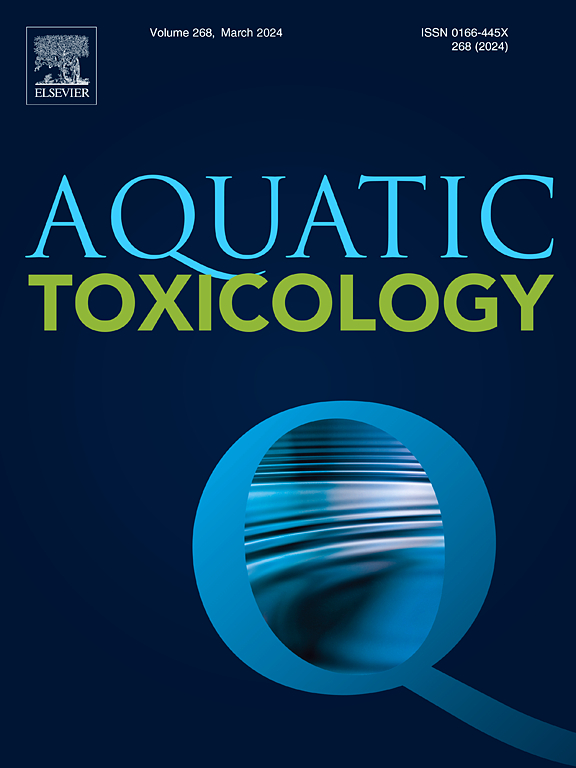Effect of temperature on the physiology and phytoremediation capacity of Spirodela polyrhiza exposed to atrazine and S-metolachlor
IF 4.1
2区 环境科学与生态学
Q1 MARINE & FRESHWATER BIOLOGY
引用次数: 0
Abstract
Environmental toxicity of pesticides to aquatic plants can vary with temperature, as temperature affects plant metabolic processes. We exposed the globally distributed duckweed Spirodela polyrhiza to environmentally relevant concentrations (40 µg/L) of atrazine and S-metolachlor at temperatures typical of surface freshwater in temperate zones (10, 15, and 21 °C). Our objective was to assess the effects of low temperatures and herbicide concentration, and their interactions, on growth, photosynthesis, pigments, antioxidant enzymes, and phytoremediation capacity. Lower temperatures (10 °C) intensified the adverse effects of both herbicides on the quantum yield of photosystem II in S. polyrhiza, with photosynthesis being a more sensitive endpoint than biomass growth rate. Both in the control and herbicide treatments, plants exposed to 10 °C exhibited lower concentrations of photosynthetic pigments (chlorophylls and carotenoids) and reduced ascorbate peroxidase activity, which may have contributed to the intensified negative effects on photosynthesis at this temperature. The removal of S-metolachlor was lower at 10 and 15 °C (3–8 %) compared to 21 °C (17 %), while no difference was observed between the three tested temperatures for atrazine (2–8 %). Our findings suggest that conducting pesticide toxicity tests at around 25 °C may underestimate the contaminants' inhibitory effects on aquatic plants during colder seasons and in temperate regions. Additionally, lower temperatures pose a challenge to the effectiveness of atrazine and S-metolachlor phytoremediation in aquatic environments.
温度对暴露于阿特拉津和s -甲草胺的多根螺旋藻生理及植物修复能力的影响
农药对水生植物的环境毒性随温度而变化,因为温度影响植物的代谢过程。我们将全球分布的浮萍多根螺旋藻暴露在与环境相关的浓度(40µg/L)的阿特拉津和s -异甲草胺中,温度为温带典型的地表淡水(10、15和21°C)。我们的目的是评估低温和除草剂浓度及其相互作用对植物生长、光合作用、色素、抗氧化酶和植物修复能力的影响。较低温度(10°C)加剧了两种除草剂对多根草光系统II量子产量的不利影响,其中光合作用是比生物量生长速率更敏感的终点。在对照和除草剂处理中,暴露于10°C的植株光合色素(叶绿素和类胡萝卜素)浓度降低,抗坏血酸过氧化物酶活性降低,这可能是该温度下对光合作用的负面影响加剧的原因。与21°C(17%)相比,10°C和15°C(3 - 8%)对s -异甲草胺的去除率较低,而阿特拉津在三种测试温度下的去除率没有差异(2 - 8%)。我们的研究结果表明,在25°C左右进行农药毒性测试可能低估了污染物在寒冷季节和温带地区对水生植物的抑制作用。此外,低温对阿特拉津和s -甲草胺在水生环境中的植物修复效果提出了挑战。
本文章由计算机程序翻译,如有差异,请以英文原文为准。
求助全文
约1分钟内获得全文
求助全文
来源期刊

Aquatic Toxicology
环境科学-毒理学
CiteScore
7.10
自引率
4.40%
发文量
250
审稿时长
56 days
期刊介绍:
Aquatic Toxicology publishes significant contributions that increase the understanding of the impact of harmful substances (including natural and synthetic chemicals) on aquatic organisms and ecosystems.
Aquatic Toxicology considers both laboratory and field studies with a focus on marine/ freshwater environments. We strive to attract high quality original scientific papers, critical reviews and expert opinion papers in the following areas: Effects of harmful substances on molecular, cellular, sub-organismal, organismal, population, community, and ecosystem level; Toxic Mechanisms; Genetic disturbances, transgenerational effects, behavioral and adaptive responses; Impacts of harmful substances on structure, function of and services provided by aquatic ecosystems; Mixture toxicity assessment; Statistical approaches to predict exposure to and hazards of contaminants
The journal also considers manuscripts in other areas, such as the development of innovative concepts, approaches, and methodologies, which promote the wider application of toxicological datasets to the protection of aquatic environments and inform ecological risk assessments and decision making by relevant authorities.
 求助内容:
求助内容: 应助结果提醒方式:
应助结果提醒方式:


